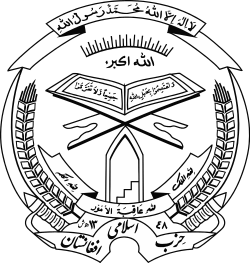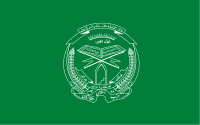Hezbi Islami
Hezbi Islami د افغانستان اسلامي حزب | |
|---|---|
 | |
| Leader | Arghandiwal |
| Founder | Gulbuddin Hekmatyar |
| Founded | 1975 |
| Preceded by | Muslim Youth |
| Succeeded by |
HIG HIK HIKF |
| Ideology | Islamism |
| Seats in the House of the People |
16 / 249
|
| Seats in the House of Elders |
0 / 102
|
| Party flag | |
 | |
Hezbi Islami (also Hezb-e Islami, Hezb-i-Islami, Hezbi-Islami, Hezb-e-Islami), meaning Islamic Party[1] is an Islamist organization that was commonly known for fighting the Communist Government of Afghanistan and their close ally the Soviet Union. Founded and led by Gulbuddin Hekmatyar, it was established in Afghanistan in 1975. It grew out of the Muslim Youth organization, an Islamist organization founded in Kabul by students and teachers at Kabul University in 1969 to combat communism in Afghanistan.[2] Its membership was drawn from ethnic Pashtuns, and its ideology from the Muslim Brotherhood and Abul Ala Maududi's Jamaat-e-Islami.[2] Another source describes it as having splintered away from Burhanuddin Rabbani's original Islamist party, Jamiat-e Islami, in 1976, after Hekmatyar found that group too moderate and willing to compromise with others.[3]
Hezbi Islami seeks to emulate the Ikhwan militia of Saudi Arabia and to replace the various tribal factions of Afghanistan with one unified Islamic state. This puts them at odds with the more tribe-oriented Taliban.[4]
Split-up Khalis faction and Hezb-e-Islami Gulbuddin
In 1979, Mulavi Younas Khalis split with Hekmatyar and established his own Hezbi Islami, known as the Khalis faction, with its power base in Nangarhar. Gulbuddin Hekmatyar's faction is since then referred to as the Hezb-e-Islami Gulbuddin, or HIG.
History 1979–2001
History since 2001
Neither Hezbi Islami nor Hezb-e-Islami Gulbuddin were on the U.S. State Department list of Foreign Terrorist Organizations from 2001 to 2006.[5] However, Hezb-e-Islami Gulbuddin is on the additional list called "Groups of Concern."[6]
In 2008, the International Security Assistance Force estimated that the military component of Hezbi Islam was about 1,000 strong, including part-time fighters.[7]
Today, the non-violent faction of the Hezbi Islami is a registered political party in Afghanistan, led by Arghandiwal.[8]
On 18 September 2012 Hezbi Islami claimed responsibility of a suicide attack in Kabul, carried out by an 18-year-old woman in which nine people were killed. They said it was in retaliation for the film Innocence of Muslims.[9] All victims were themselves Muslim.
On 16 May 2013 Hezbi Islami claimed responsibility for another attack in Kabul in the form of an explosive-loaded Toyota Corolla that was rammed into a pair of American military vehicles in which 16 people were killed.[10]
See also
Sources
- ↑ Pike, John (August 8, 1998). "Hizb-i-Islami (Islamic Party)". Intelligence Resource Program. Federation of American Scientists. Retrieved March 13, 2012.
- 1 2 Roy, Oliver; Sfeir, Antoine (2007). The Columbia World Dictionary of Islamism. Columbia University Press. p. 132.
- ↑ Haqqani, Husain (2005). Pakistan: Between Mosque and Military. Carnegie Endowment. p. 173. Retrieved 2 November 2014.
- ↑ Seth Jones, "The Rise of Afghanistan's Insurgency: State Failure and Jihad", International Security, vol 32, no. 4 (2008) pages 28–29
- ↑ "2001 Report on Foreign Terrorist Organizations", "Fact Sheet: Foreign Terrorist Organizations List" October 23, 2002 Archived February 15, 2008, at the Wayback Machine., "Fact Sheet: Foreign Terrorist Organizations List" January 30, 2003, "Fact Sheet: Foreign Terrorist Organization Designations Table" December 30, 2004, "Fact Sheet:Foreign Terrorist Organizations (FTOs)" October 11, 2005 Archived December 10, 2008, at the Wayback Machine., "Country Reports on Terrorism: Chapter 8 -- Foreign Terrorist Organizations" April 28, 2006 Archived March 11, 2007, at the Wayback Machine.
- ↑ "U.S. Designates Foreign Terrorist Organizations: List includes 42 groups, 43 others deemed “of concern”" April 30, 2007
- ↑ Tyson, Ann Scott (June 15, 2008). "A Sober Assessment of Afghanistan". The Washington Post. Retrieved March 13, 2012.
There are an estimated 5,000 to 20,000 Taliban fighters in Afghanistan, plus an estimated 1,000 each for the insurgent groups led by Siraj Haqqani and Gulbuddin Hekmatyar, according to ISAF intelligence.
- ↑ Political parties/groups and leaders in Afghanistan
- ↑ Suicide attack in Afghan capital claimed by Hezb-e-Islami
- ↑ , New York Times, 2013